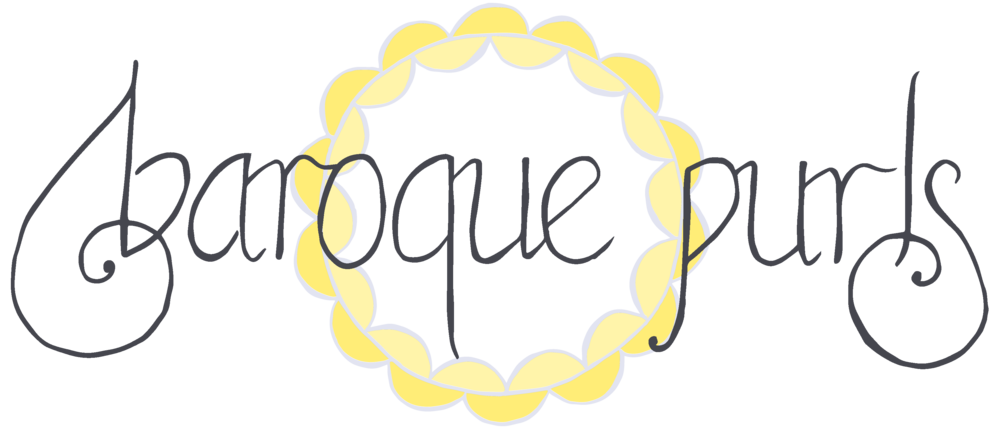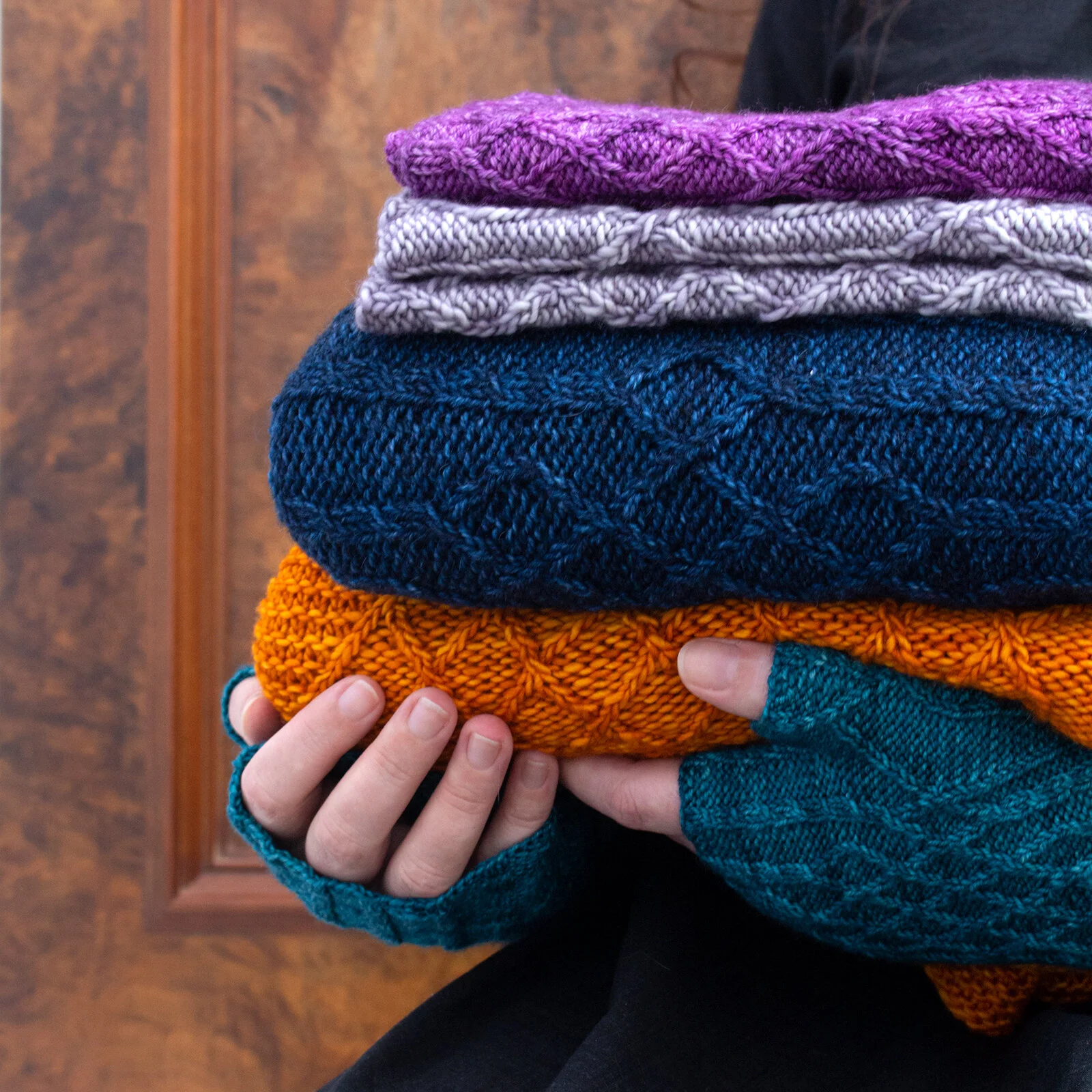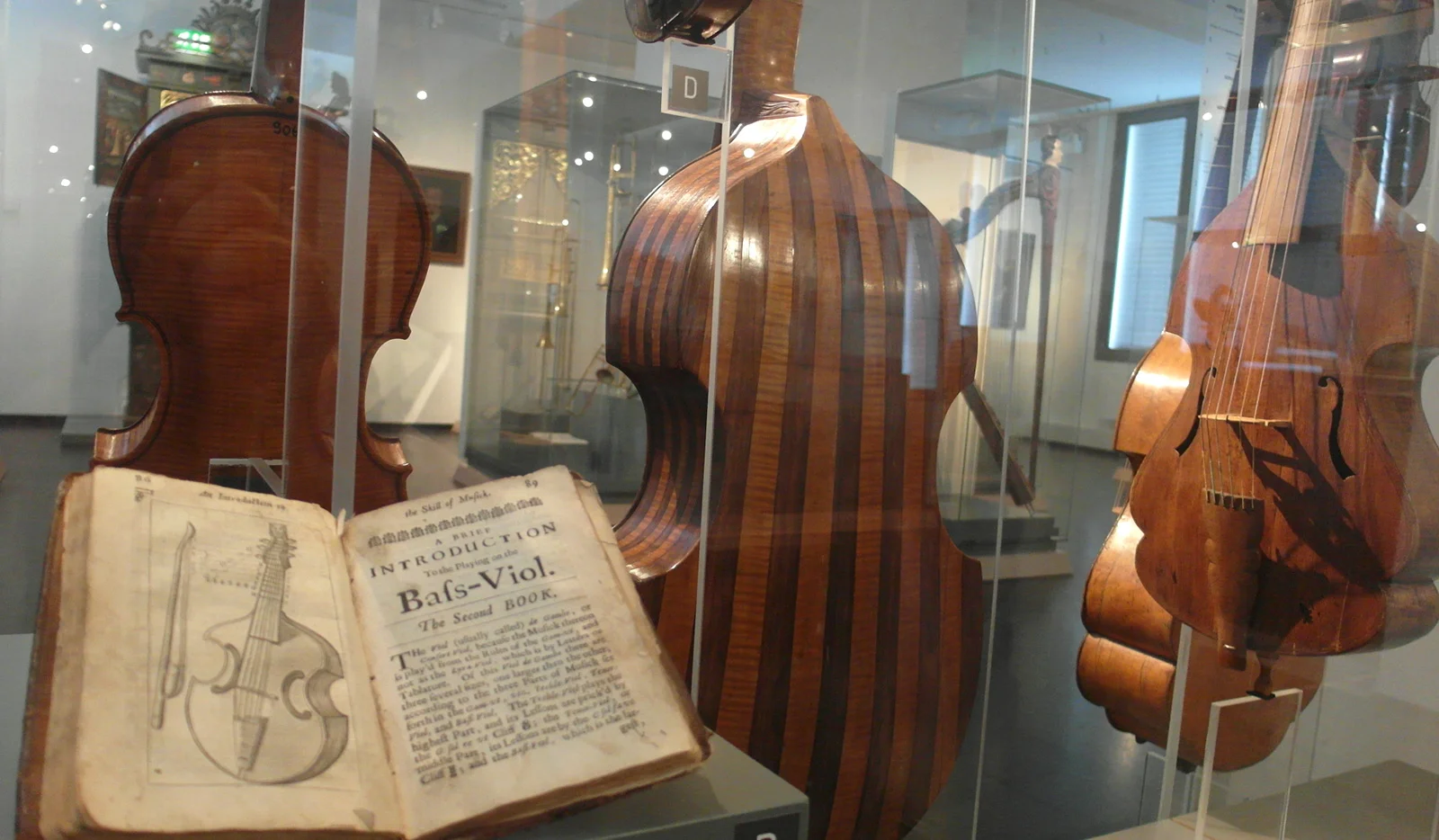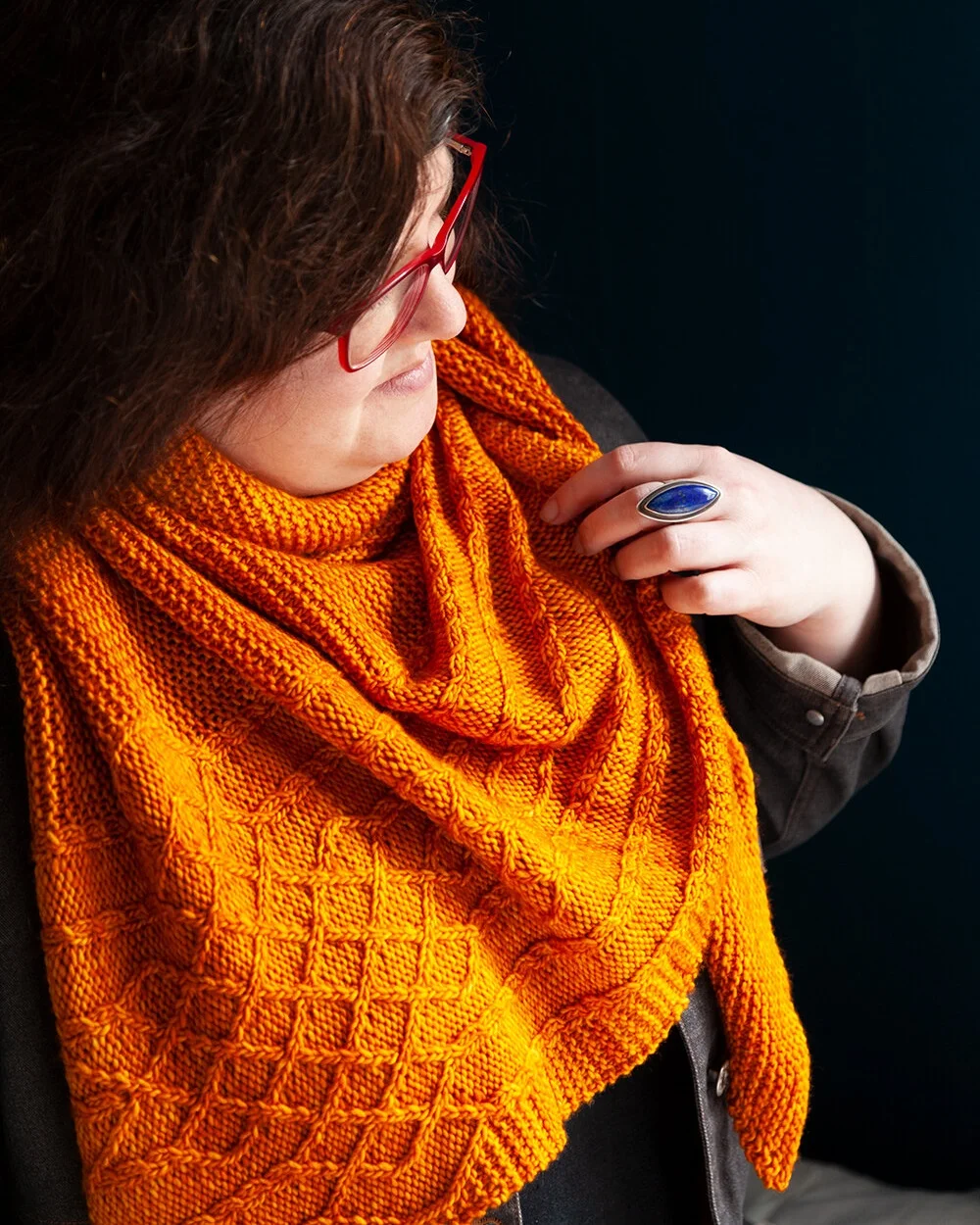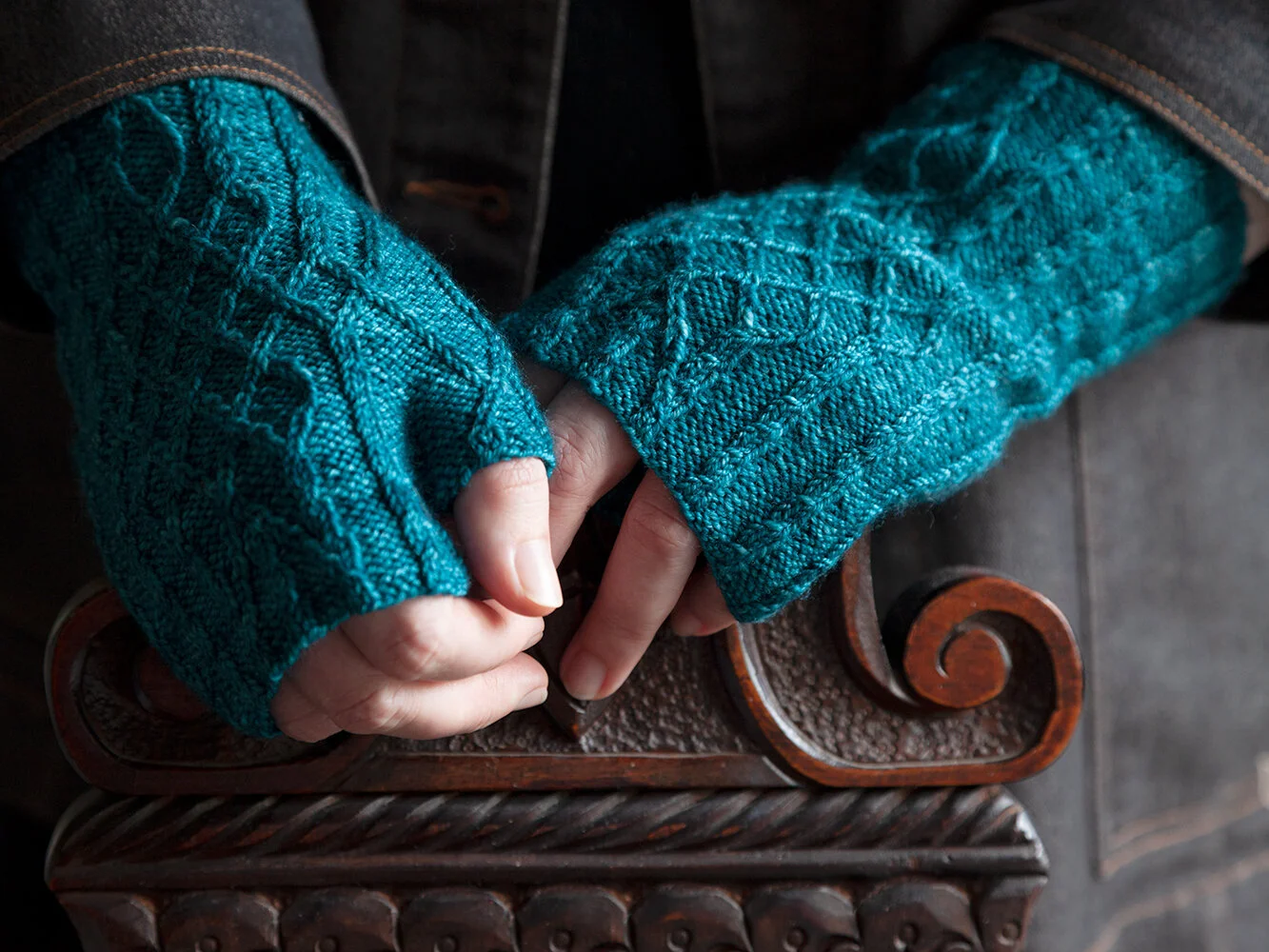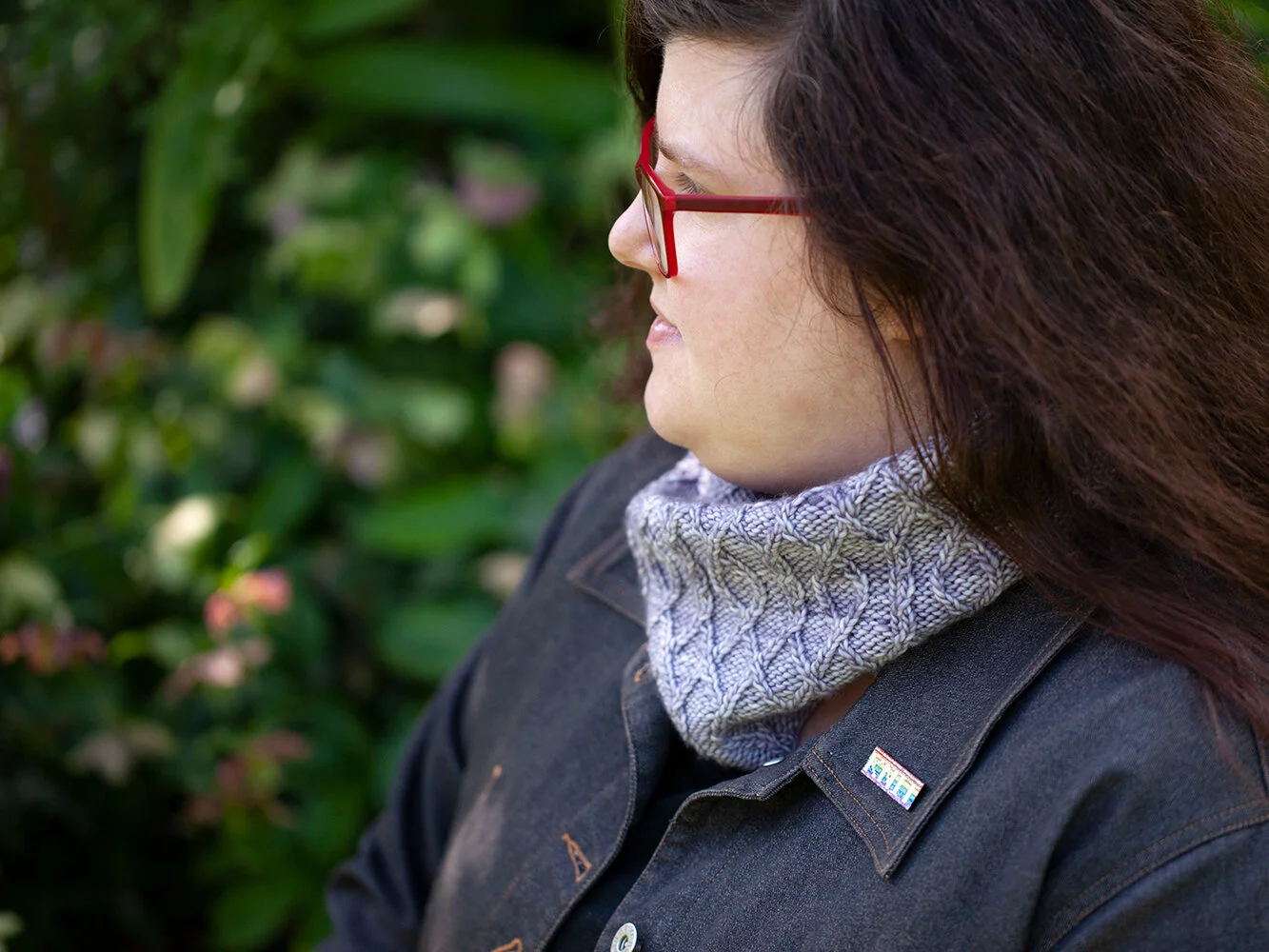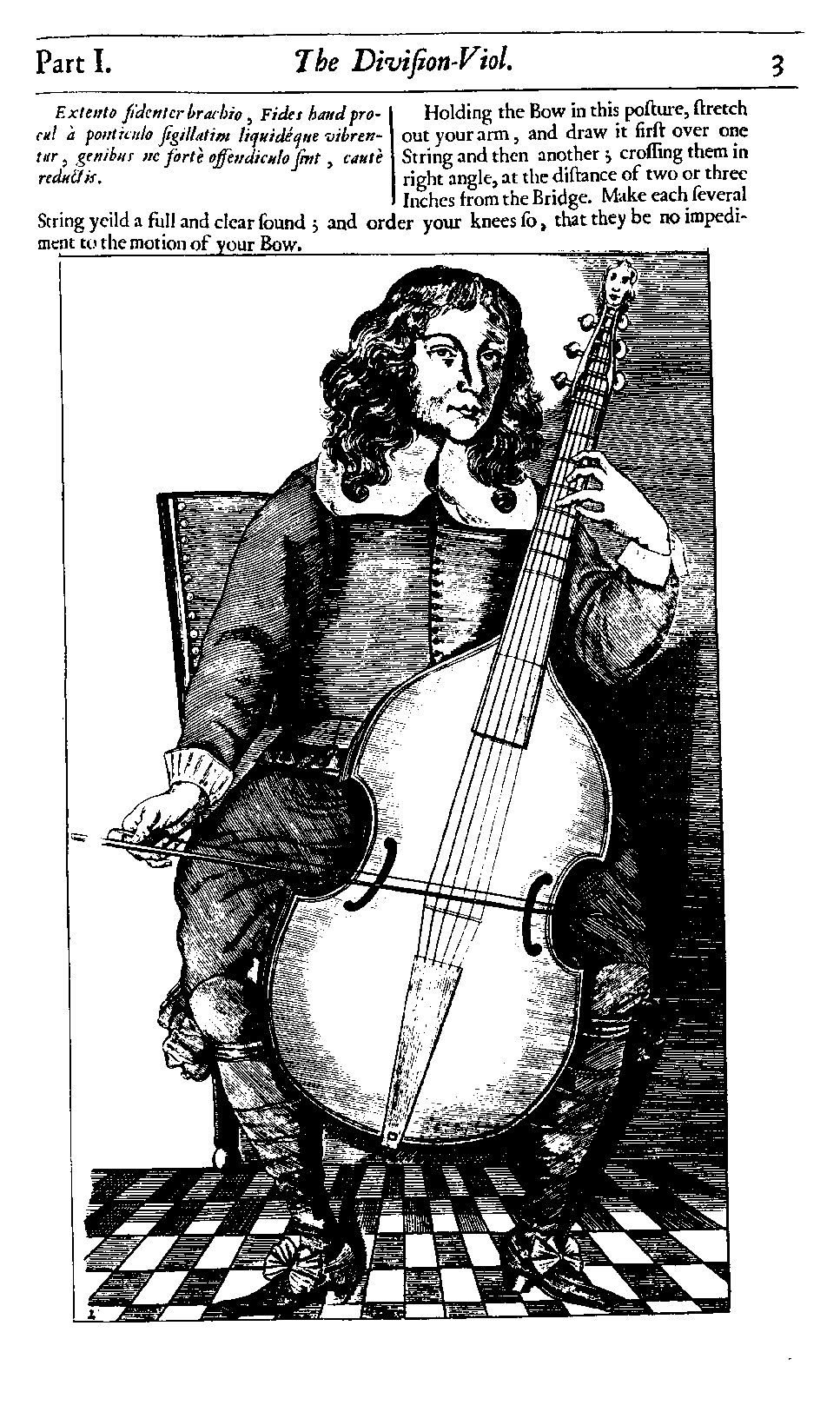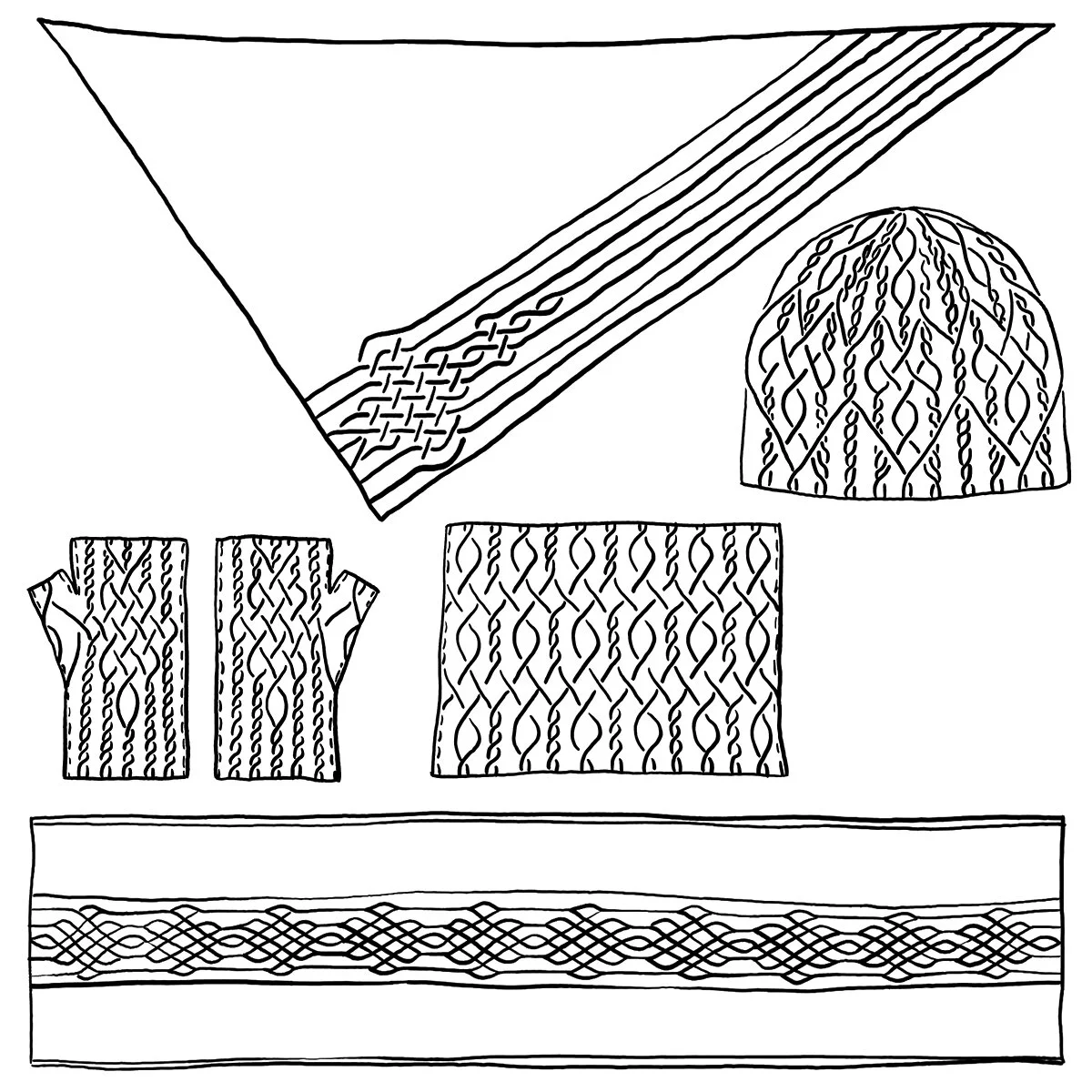My preferred method for ripping back several rows/rounds is to use an ‘afterthought lifeline’, inserting another circular needle through each stitch of the round you want to start again from. Taking the time to do this before ripping back reduces the chance of losing stitches and spending even more time and trouble retrieving them.
Read MoreNew collection: Twisted Strings
I’ve been dreaming of making this collection a reality for literally years, and I’m so happy to be able to present it to the world! Twisted Strings is a collection of five accessories inspired by the decorative tracery found on Baroque string instruments, in unapologetic celebration of my particular brand of nerdery. The names of the individual designs - the Dowland Wrap, Tielke Shawl, Playford Hat, Jaye Mitts, and Simpson Cowl - are borrowed from seventeenth-century composers, instrument-makers, and music teachers and publishers.
My interest in the seventeenth-century musical world is a long-standing thing - I studied various aspects of it in my university days, which I touched on in my earlier post Why ‘Baroque Purls’? At around the same time I took up playing the viol - badly - before moving on to singing, which happily was a much better fit for me. I still enjoy messing around with songs from this period, but my cats do tend to object.
A couple of years ago I was fortunate enough to visit Europe for the first time, and one of the big highlights for me was visiting Leipzig and its Bach Museum, churches, and Museum of Musical Instruments. I took a ridiculous number of photos, some of which you can see below, and I took my inspiration for the cable patterns in this collection directly from a few of the decorative details I captured.
If you’re interested, you can find more examples of beautiful historical instruments in the Orpheon collection, and via the MIMO (Musical Instrument Museums Online) database, which I wish had existed when I was at uni!
A case full of viols, and an early edition of Playford’s Introduction to the Skill of Musicke (Musikinstrumentenmuseum der Universität Leipzig, 2016)
This clavichord was one of the few instruments we were allowed to touch (Musikinstrumentenmuseum der Universität Leipzig, 2016)
Dowland Wrap:
Named for the composer John Dowland, famous for his melancholy songs and instrumental works for viols, the Dowland Wrap is a dramatic rectangular wrap featuring a central cable panel flanked by contrasting garter stitch.
Contrabass, Italy, mid-17thC (Musikinstrumentenmuseum der Universität Leipzig)
From ‘Flow my teares’, a lute song from Dowland’s Second Booke of Songs or Ayres (1600)
Dowland Wrap features:
a rectangular wrap worked from end to end
a central cable panel inspired by the geometric tracery decorating 17thC string instruments, with wide garter stitch edges for textural contrast
simple 1-over-1 cables, which can be knit without a cable needle (instructions for my favourite twist method are included)
requires 5 skeins of Malabrigo Dos Tierras (50% baby alpaca, 50% merino wool; 210yds/192m per 100g skein), or 1050yds/960m of DK-weight yarn. Sample colourway: ‘Azul Profundo’
72.5”/184cm long and 17.5”/44.5cm wide, relaxed after blocking
charts and written instructions are both provided in full.
Tielke shawl:
The Tielke Shawl is an asymmetric triangular shawl featuring a garter stitch ground and a cable panel which grows in complexity as you knit: it flows from simple twisted cables, representing the strings of musical instruments, into a complex intertwining motif. The shawl is named for the Tielke family of musical instrument makers - Joachim, who created richly decorated instruments in his Hamburg workshop, and Gottfried, who made the five-stringed contrabass (now in Leipzig’s musical instrument museum), which inspired the shawl’s cable detail.
Contrabass by Gottfried Tielke, 1662 (Musikinstrumentenmuseum der Universität Leipzig)
Tielke Shawl features:
an asymmetric triangular shawl worked from one point to the opposite side
simple garter stitch with a cable panel running along one edge, inspired by the geometric motif decorating a 17thC contrabass
simple 1-over-1 cables, which can be knit without a cable needle (instructions for my favourite twist method are included)
requires 4 skeins of Malabrigo Washted (100% superwash merino wool; 210yds/192m per 100g skein), or 820yds/750m of worsted-weight yarn. Sample colourway: ‘Sunset’
74.5”/189cm wingspan and 31.5”/80cm depth, relaxed after blocking
charts and written instructions are both provided in full.
Playford hat:
The Playford Hat is named for the music publisher and bookseller John Playford, known for publishing music by various composers, the collection of dance melodies and steps The English Dancing Master, and instructional books for various instruments including the violin. The hat’s all-over cable pattern is inspired by the delicate latticework framed with hearts inscribed on a beautiful violin by Hans Krouchdaler (circa 1700).
Playford Hat features:
a cabled beanie worked in the round from the bottom up
an all-over cable pattern inspired by the geometric lattices framed with hearts on a highly-decorated Baroque violin
simple 1-over-1 cables, which can be knit without a cable needle (instructions for my favourite twist method are included)
requires 1 skein of Malabrigo Arroyo (100% superwash merino wool; 335yds/306m per 100g skein), or 205yds/187.5m of sport-weight yarn. Sample colourway: ‘Borraja’
18”/46cm circumference and 8.75”/22.5cm length, relaxed after blocking
to fit 19-23”/48-58.5cm head circumference
charts and written instructions are both provided in full.
From The English Dancing Master (1651)
Jaye mitts:
The Jaye Mitts, named for the viol-maker Henry Jaye, are a pair of fingerless mitts featuring a delicately intertwining cable motif, and simple twisted cables on the palms representing the strings of musical instruments. Many modern viols being played today are careful copies of Jaye’s original instruments.
Jaye Mitts features:
a cabled pair of mitts worked in the round from the bottom up
cable motifs inspired by the geometric decoration on a 17thC descant viol, and plain twisted cables on the palm side
simple 1-over-1 cables, which can be knit without a cable needle (instructions for my favourite twist method are included)
requires 1 skein of Malabrigo Sock (100% superwash merino; 440yds/402m per 100g skein), or 196.5yds/180m of light fingering weight yarn. Sample colourway: ‘Teal Feather’
7”/18cm circumference and 7.25”/18.5cm length, relaxed after blocking
to fit 7-8.5”/18-21.5cm palm circumference
charts and written instructions are both provided in full.
Descant viol by Henry Jaye, mid-17thC (Musikinstrumentenmuseum der Universität Leipzig)
Simpson cowl:
The Simpson Cowl is named for viol-player and composer Christopher Simpson, who wrote The Division Viol to teach players how to embellish and improvise on a melody or bass line. The short cowl is worked in the round, and features an all-over pattern of intertwining cable motifs which I extrapolated from the lattice motifs found on various seventeenth-century viols and other instruments.
Simpson Cowl features:
a cabled cowl knit in the round from the bottom up
an all-over cable pattern inspired by the decorative latticework on 17thC string instruments
simple 1-over-1 cables, which can be knit without a cable needle (instructions for my favourite twist method are included)
requires 1 skein of Malabrigo Washted (100% superwash merino wool; 210yds/192m per 100g skein), or 201yds/184m of worsted-weight yarn. Sample colourway: ‘Pearl’
22”/56cm circumference and 8.5”/21.5cm depth, relaxed after blocking
charts and written instructions are both provided in full.
From The Division-viol, or The Art of Playing ex tempore to a Ground (1665)
The cable patterns featured in these designs have some elements in common across the whole collection, most notably interwoven latticework motifs of varying complexity, combined with 2-stitch cable ribs which symbolise the twisted strings of musical instruments. The cable patterns are relatively fuss-free, and can be worked entirely without a cable needle - instructions for my favourite method are included in the patterns, and you can also find my tutorial here. You will come across a few stitches worked through the back loop (because they give a crisper look to the cable tracery), but I’ve kept these to a minimum for the sake of ease.
All five patterns are available for download on Ravelry and Payhip, where you can find additional photos and details, and purchase them individually or together in an ebook (with a reduced price per pattern).
How to work mini-bobbles
When I came up with the idea for my Xerophyte Shawl (you can read about its inspiration here), I wanted to include bobbles at intervals in the stockinette fabric - but working hundreds of full-sized bobbles was more effort than I was honestly prepared to make. And so I was very happy to come across Sarah Wilson’s article for Interweave, 5 Ways to Work a Bobble, which includes a method for making mini-bobbles using a wrapped-stitch method sometimes known as the Estonian Button Stitch. This method has the advantage of producing a small, flattish bobble without needing to turn your work, and is much faster than any other bobble method I’ve tried.
Read MoreNew patterns: Orfeo Hat & Cowl
This pair of patterns has been almost a year in the making, and my obsession with stranded colourwork is still going strong! The Orfeo Hat & Cowl feature colourwork inspired by the decorative stamped motifs found in seventeenth-century books and music scores. I enjoy spotting all the little decorative elements when I’m looking through an old music score, finding something new to sing or checking a detail of an old favourite, and when I find a motif that has knitting-design potential I do a quick sketch and make a note of where I found it. The IMSLP database is a fantastic treasure trove of public-domain music scores, and it’s where I go to find most of my sheet music these days.
Warning: more music-historical geekiness ahead!
The motifs I used as the starting point for my Orfeo Hat & Cowl come from some early editions of music by Claudio Monteverdi, one of my top two favourite composers (the other is J.S. Bach). The same tiny, tiling motifs appear on the title page of Monteverdi’s opera L’Orfeo (1609) and his Vespro della Beata Vergine (1610), which were both published by Venetian music printer Ricciardo Amadino. You can see the motifs below, forming the border of a page.
Motifs which can be combined in various different configurations are brilliant for creating a stitch pattern, and the shape of these reminds me of elaborate lyres or c-clefs. To create my colourwork pattern I traced enlarged versions of the motifs onto squared paper and added clean straight lines to contain them. To me, the contrast between the elements creates movement and drama, and feels very baroque.
The yarn I chose for my samples is Outlaw Yarn’s Bohemia Sport (45% Polwarth, 45% Alpaca, 10% Possum; 183yds/167m per 50g skein). When I was still at the swatching stage for these designs I asked around on Instagram for recommendations for good yarn for stranded colourwork, and I’m glad I went with this suggestion. It’s soft and warm, the fuzzy halo helps the stitches ‘mesh’ well without obscuring the design, and it can be worked at a tight gauge, which is how I prefer my colourwork.
I used half a skein of each colour for the hat, and a little over one skein of each colour for the cowl - so if you’d like a matching set, two skeins of each colour will be plenty. The colours I picked are Parchment for the hat’s main/background colour (MC), Gaslight for the cowl’s MC, and Leadlight for the contrast/motif colour (CC) for both. Leadlight has unfortunately been discontinued since I knit my two samples, but the new colour Erebus is a great substitute - it’s a dark blue/charcoal shade, whereas Leadlight was plain black.
I chose the Twisted German Cast On for both the hat and cowl because it’s quite substantial as well as stretchy, but you can use any cast on you prefer for 1x1 ribbing, e.g. Tubular, Long Tail, Alternate Cable, etc. I used this tutorial to remind myself how to work the Twisted German method: Photo Tutorial: Twisted German / Old Norwegian Cast-On.
Once you get into the colourwork, there will be some rounds with longer floats which you will need to ‘trap’ on the reverse side. I found a few good tutorials for this, including Andrea Rangel’s Catching Floats in Colorwork, Dianna Walla’s trapping long floats in stranded colorwork, and Ann Kingstone’s Trapping Floats. It does interrupt the flow of your knitting, but I feel it’s worth it to tidy up the long floats so they won’t snag on things and pull your stitches out of place.
Orfeo Hat features:
a stranded colourwork beanie knit in the round from the bottom up
swirling colourwork motifs which grow out of the corrugated ribbing of the brim, and simpler abstract colourwork in the crown shaping
hat dimensions: 18”/46cm circumference and 8.5”/21.5cm length, to fit adult head sizes ranging from 19-22”/48-56cm head circumference
requires 101yds/92.5m of the main/background colour (MC) + 102yds/93.5m of the contrast/motif colour (CC) in sport- or fingering-weight yarn
pattern includes charted stitch patterns only.
Orfeo Cowl features:
a stranded colourwork cowl knit in the round from the bottom up
swirling colourwork motifs edged with corrugated ribbing
cowl dimensions: 27”/68.5cm circumference and 10”/25.5cm height
requires 216yds/197m of the main/background colour (MC) + 209yds/191m of the contrast/motif colour (CC) in sport- or fingering-weight yarn
pattern includes charted stitch patterns only.
The Orfeo Hat and Orfeo Cowl patterns are available on Ravelry and Payhip, both individually and as an ebook (with a reduced price per pattern).
How to work p2tog and ssp decreases
Most of my lace designs feature stitch patterns with ‘rest rows’, i.e. without increases or decreases on the wrong side (WS) rows (or similarly, every second round in a hat or cowl worked in the round). But two of my recent lace creations, the Beanstalk Shawl and Ensata Scarf, require working increases and decreases on every row. This is where the purled decreases p2tog and ssp come in, which are worked on the WS and look just like k2tog and ssk when viewed on the right side (RS) of the fabric. P2tog is the more straightforward of the two, while ssp involves a few steps.
Read More